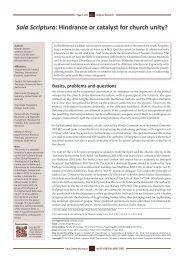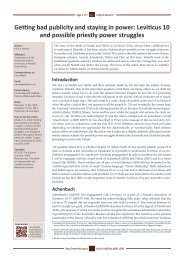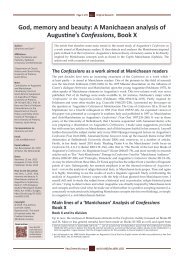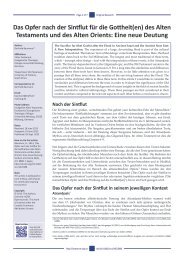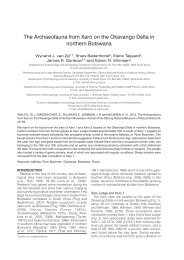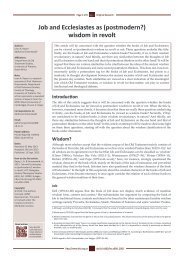Development of a Rift Valley fever real-time RT-PCR assay that can ...
Development of a Rift Valley fever real-time RT-PCR assay that can ...
Development of a Rift Valley fever real-time RT-PCR assay that can ...
Create successful ePaper yourself
Turn your PDF publications into a flip-book with our unique Google optimized e-Paper software.
W.C. Wilson et al. / Journal <strong>of</strong> Virological Methods 193 (2013) 426–431 427<br />
experimental inactivated RVFV vaccine with limited availability<br />
(Rusnak et al., 2011). Veterinary vaccines used in endemic and<br />
epidemic countries include a formalin-inactivated vaccine and an<br />
attenuated vaccine strain (Smithburne neurotropic strain) <strong>that</strong> was<br />
developed in 1949 (Gerdes, 2002; Smithburn, 1949). A naturally<br />
attenuated strain isolated from an asymptomatic human case in<br />
the Central Afri<strong>can</strong> Republic, Clone 13, which has a large deletion in<br />
the open reading frame <strong>of</strong> the NSs protein, has been demonstrated<br />
to be safer than the Smithburn attenuated vaccine strain, which<br />
<strong>can</strong> cause abortions (Dungu et al., 2010; von Teichman et al.,<br />
2011). Clone 13 is now commercially available for use in livestock<br />
in South Africa. Other attenuated vaccine <strong>can</strong>didates have been<br />
investigated and preliminary results are promising, but these<br />
<strong>can</strong>didates are not yet licensed for human or animal use (Bird<br />
et al., 2008; Morrill and Peters, 2011) (for a recent review refer to<br />
Ikegami and Makino (2009)). An important feature <strong>of</strong> these newer<br />
veterinary vaccines is the ability to differentiate infected from<br />
vaccinated animals (DIVA). To employ a DIVA control strategy<br />
effectively, relevant companion diagnostic <strong>assay</strong>s are required.<br />
The RVFV genome consists <strong>of</strong> three negative sense, singlestranded<br />
RNA segments encoding structural and non-structural<br />
proteins. The large segment (L) encodes the RNA-dependent<br />
RNA polymerase which associates with the nucleocapsid protein<br />
(encoded by the small (S) segment) and genome segments to form<br />
ribonucleocapsids. The S-segment, which utilizes an ambisense<br />
coding strategy, additionally encodes a non-structural protein<br />
(NSs), which is the virulence factor <strong>of</strong> the virus <strong>that</strong> counteracts the<br />
host innate immune response. The medium (M) segment encodes<br />
two major envelope glycoproteins and two minor proteins, one <strong>of</strong><br />
which is non-structural and may have anti-apoptotic properties<br />
(Won et al., 2006).<br />
Diagnostic <strong>assay</strong>s for detection <strong>of</strong> RVFV antibodies and antigen<br />
have been developed. Various enzyme-linked immunosorbent<br />
<strong>assay</strong>s (ELISAs) have been developed for the detection <strong>of</strong> antibodies<br />
to RVFV in humans, sheep, cattle and wildlife species (Meegan et al.,<br />
1987; Paweska et al., 2005a,b, 2008; Williams et al., 2011). Antigen<br />
capture ELISAs are also available (Fukushi et al., 2012; Morvan<br />
et al., 1991; Jansen van Vuren and Paweska, 2009). Rapid RVFV<br />
RNA detection methods using <strong>real</strong>-<strong>time</strong> reverse transcriptasepolymerase<br />
chain reaction (r<strong>RT</strong>-<strong>PCR</strong>) have also been reported (Bird<br />
et al., 2007a; Drosten et al., 2002; Garcia et al., 2001). In addition, a<br />
<strong>real</strong>-<strong>time</strong> reverse transcription loop-mediated isothermal amplification<br />
(LAMP) test for rapid detection <strong>of</strong> RVFV has been developed<br />
(Euler et al., 2012; Le Roux et al., 2009; Peyrefitte et al., 2008).<br />
Recently, methods for rapid inactivation <strong>of</strong> the virus and single-step<br />
r<strong>RT</strong>-<strong>PCR</strong> for detection <strong>of</strong> RVFV RNA were developed (Drolet et al.,<br />
2012). None <strong>of</strong> these tests are compatible or applied as a DIVA companion<br />
diagnostic <strong>assay</strong>. Furthermore, the need for detection <strong>of</strong> an<br />
introduced foreign animal pathogen is substantiated by its signifi<strong>can</strong>t<br />
economic impact. Therefore, in this study a robust one-step<br />
quadruplex r<strong>RT</strong>-<strong>PCR</strong> <strong>assay</strong> was developed <strong>that</strong> allows for DIVA compatibility,<br />
detection confirmation, and exogenous internal control<br />
amplification.<br />
2. Materials and methods<br />
2.1. Viruses<br />
RVFV MP-12 was propagated in fetal lung fibroblast (MRC-5)<br />
cell cultures. Propagation <strong>of</strong> RVFV strains from varying geographical<br />
and locations over 63 years was done in confluent Afri<strong>can</strong><br />
green monkey kidney epithelial cells (Vero). Cells were infected<br />
using 0.01 multiplicity <strong>of</strong> infection and RNA extractions were performed<br />
when approximately 80–95% <strong>of</strong> the infected cells showed<br />
cytopathology.<br />
2.2. RNA extraction from infected cells or serum<br />
Total RNA was extracted from cells using a variety <strong>of</strong> RNA<br />
isolation kits as per the manufacturer’s protocols. The choice <strong>of</strong><br />
extraction kit was based on local availability and/or preferences.<br />
RNA from RVFV propagated in cell culture was isolated using Trizol<br />
LS according to the manufacturer’s recommendations (Life Technologies,<br />
Inc., Grand Island, NY). The primary method used for<br />
serum or tissue samples was the high-throughput RNA extraction<br />
method using the magnetic-bead capture kits: MagMAX-96<br />
total RNA Isolation and MagMAX Viral RNA Isolation. Briefly,<br />
130 l <strong>of</strong> lysis/binding buffer was added to 50 l <strong>of</strong> sample and<br />
mixed by shaking in a 96-well plate. Bead mix (20 l) was then<br />
added and the mixture was shaken for 5 min. Four subsequent<br />
washes were performed (150 l each) and the RNA was eluted<br />
in 50 l <strong>of</strong> elution buffer at 65 ◦ C. RNA was extracted both manually<br />
and automatically using available commercial kits in use<br />
at the various cooperating laboratories. The primary kit used in<br />
development <strong>of</strong> the <strong>assay</strong> was the Applied Biosystems MagMax<br />
Express system (Life Technologies, Inc., Grand Island, NY). RNA<br />
was quantitated using UV spectroscopy. RNA from veterinary clinical<br />
samples was purified using the MagNA Pure High Performance<br />
Total Nucleic Acid Isolation Kit together with the MagNA Pure LC<br />
according to manufacturers specifications (Roche Applied Science,<br />
South Africa).<br />
2.3. Primer/probe design<br />
The initial primer and probe design was based on previous <strong>real</strong><strong>time</strong><br />
<strong>assay</strong>s (Bird et al., 2007a; Drosten et al., 2002; Garcia et al.,<br />
2001). Subsequent new primer and probes were designed using<br />
Visual OMP (DNA S<strong>of</strong>tware, Ann Arbor, MI). The RVFV vaccine<br />
strain, MP-12, was used as a model virus for many <strong>of</strong> the studies due<br />
to lack <strong>of</strong> local access to an approved BSL-3+ laboratory for virulent<br />
RVFV. The L segment primer design was modified when MP-12 was<br />
used to account for sequence variation. The two exogenous internal<br />
control RNA primer and probe combinations were based on<br />
previously published <strong>assay</strong>s (Drolet et al., 2012; Schroeder et al.,<br />
2012). The final primer design contained 4 primer sets and probes<br />
(Tables 1 and 2).<br />
2.4. Optimization <strong>of</strong> new RVFV signatures for <strong>real</strong>-<strong>time</strong> <strong>RT</strong>-<strong>PCR</strong><br />
(r<strong>RT</strong>-<strong>PCR</strong>)<br />
The r<strong>RT</strong>-<strong>PCR</strong> procedure was performed as described previously<br />
(Wilson et al., 2009a,b). Optimization <strong>of</strong> the primer and<br />
probes were conducted individually, followed by multiplexing.<br />
Various quenchers and fluorescent dyes were evaluated using<br />
limit <strong>of</strong> detection (LOD) studies on the instruments available.<br />
The primary instrument used for a small number <strong>of</strong> samples<br />
was the Cepheid SmartCycler II (Cepheid Inc., Sunnyvale, CA),<br />
while for high-throughput the Agilent MX3005p (Agilent Technologies,<br />
Inc., Santa Clara, CA) was used. The initial evaluation <strong>of</strong><br />
the primer probe designs was done using various plasmids containing<br />
RVFV target L, M and S sequences. For LOD experiments,<br />
samples were run in triplicate with viral RNA purified from 10-<br />
fold dilutions <strong>of</strong> RVFV MP-12 titered stock or in duplicate from<br />
a virulent RVFV titered stock. In some cases plasmids containing<br />
the target virulent RVFV sequences were used to facilitate optimization.<br />
Ct values were recorded and the mean and standard<br />
deviations calculated. Initial experiments were conducted with<br />
only the RVFV signatures and optimized using the iCycler (Bio-<br />
Rad, Hercules, CA). Two external RNA amplification controls were<br />
later added, optimized and evaluated on the Cepheid SmartCycler<br />
II.



